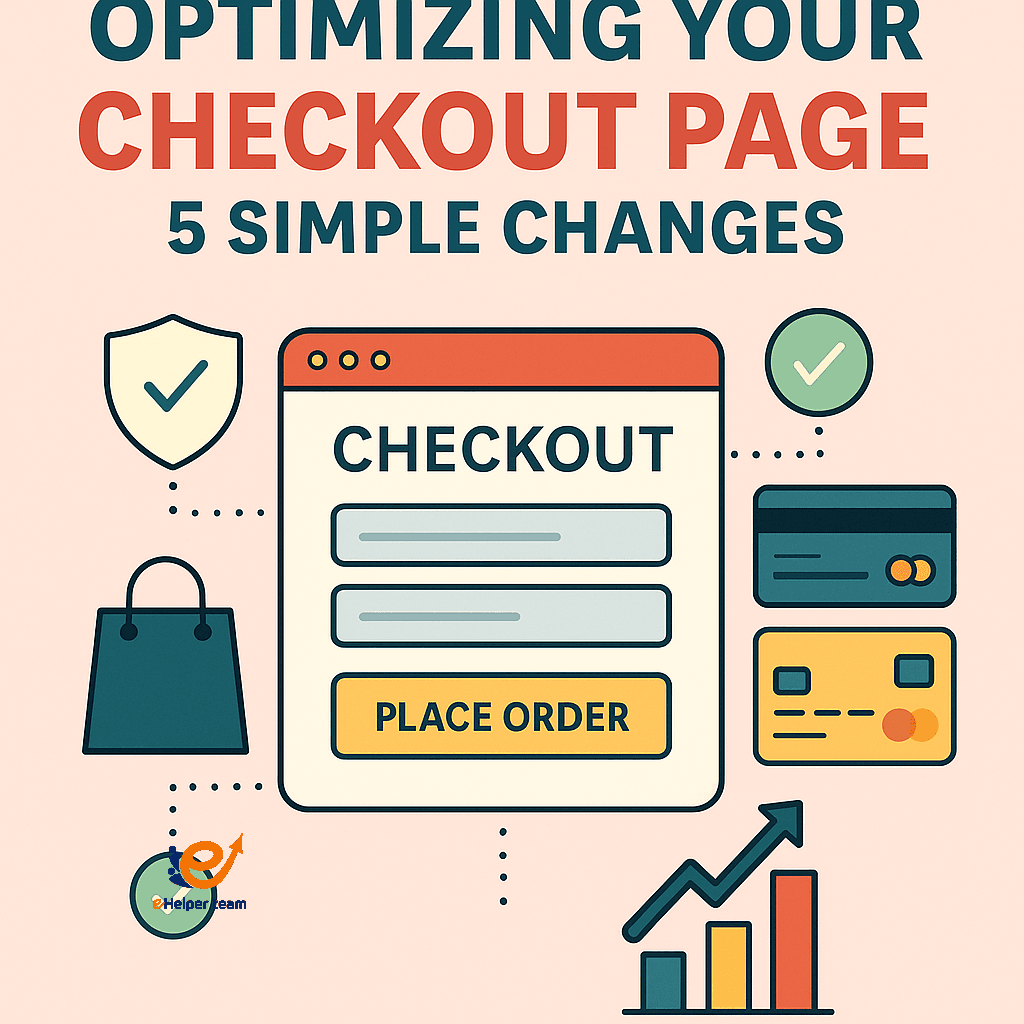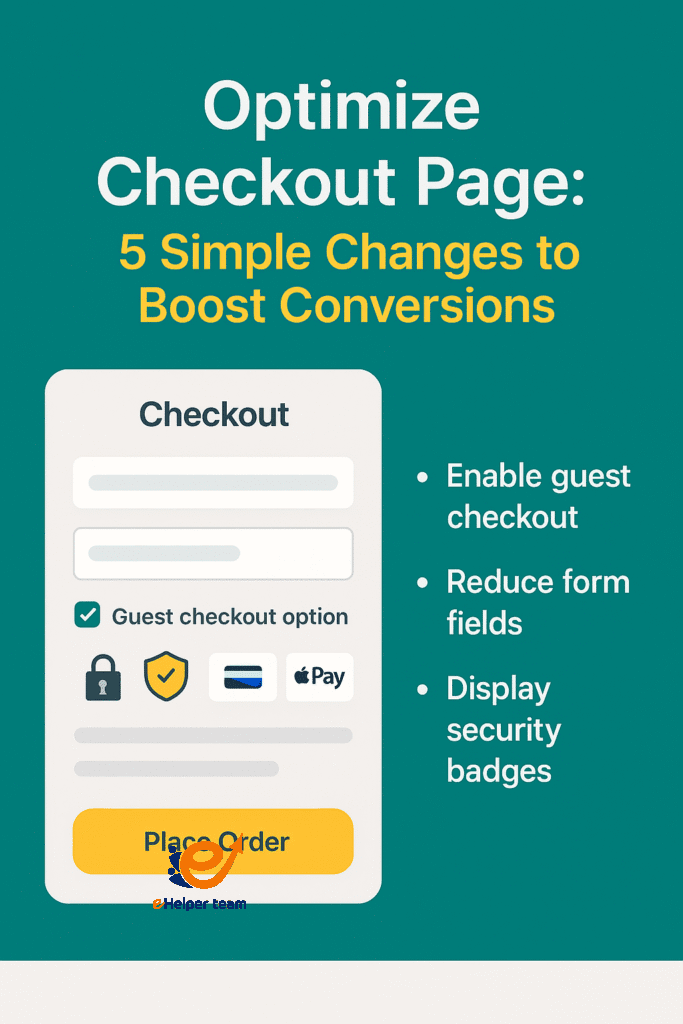Optimize Checkout Page: 5 Simple Changes to Boost Conversions
Have you ever wondered why shoppers eagerly add items to their cart only to disappear at the final step? Despite having an attractive storefront and great products, many businesses lose sales at the very last stage. The answer often lies in how you optimize checkout page to make it smoother and less frustrating for customers.
Think about it—how many times have you personally abandoned a cart because the form was too long, payment options were limited, or you weren’t sure if the site was secure? These seemingly small details can create huge friction, pushing potential buyers away. For online stores targeting the US and UK markets, where customer expectations are sky-high, every second of checkout experience matters.
So the big question is: what simple changes can transform your checkout page into a conversion powerhouse? In this article, we’ll explore five proven strategies—from offering a guest checkout option to displaying trust-building security seals—that can significantly reduce friction, build customer confidence, and ultimately increase your revenue. Let’s break down each step and see how small tweaks can drive big results.

Understanding the Checkout Experience
Why the Checkout Page is a Sales Decider
The checkout page is the moment of truth. Customers are already convinced enough to add products to their cart, but the wrong experience can derail the entire process. If your page asks for unnecessary details, lacks transparency, or doesn’t provide secure payment signals, abandonment rates spike.
Statistics That Prove the Point
Over 70% of online shoppers abandon carts due to unnecessary steps.
18% of buyers leave because the checkout process is too complicated.
17% drop out because they don’t trust the payment security.
Clearly, a frictionless checkout is not optional—it’s essential.
5 Simple Changes to Optimize Checkout Page
1. Enable Guest Checkout Option
One of the fastest ways to reduce friction is to allow buyers to check out without creating an account. Forcing registrations adds unnecessary barriers. By introducing a guest checkout option, you make the process seamless.
Retailers who implemented guest checkout reported an immediate improvement in conversion rates. Think about it: not every buyer wants to sign up, especially for a one-time purchase.
2. Minimize Form Fields
Long forms scare customers away. If you’re asking for irrelevant details like company name, fax number, or secondary phone, you’re likely losing sales. By minimizing form fields, you reduce cognitive load and speed up the process.
A real-world study showed that reducing fields from 14 to 6 increased conversions by 20%. Every field you remove is another obstacle gone.
3. Show Security Seals and Trust Badges
Would you hand over your credit card details to a site that doesn’t look secure? Neither would most customers. Displaying security seals such as SSL badges, payment provider logos, and trust marks reassures buyers that their data is safe.
This is where credibility plays a huge role. Just adding visible SSL trust seals and emphasizing encrypted payments can dramatically lower cart abandonment.
4. Offer Multiple Payment Options
Customers in the US and UK expect flexibility in payments. If you’re offering only credit card checkout, you’re limiting your potential. By integrating multiple payment options like PayPal, Apple Pay, Google Pay, and even Buy Now, Pay Later (BNPL) services, you expand your reach.
This is backed by research shared in this guide on best payment gateways, showing how offering broader payment methods can directly reduce drop-offs.
5. Improve Page Speed and Mobile Optimization
Did you know a delay of even 1 second can cost you thousands in lost sales? Page speed directly affects conversions. Optimizing mobile responsiveness and ensuring that checkout is fast and intuitive on all devices is critical.
Slow-loading payment gateways or clunky mobile layouts drive users away. Make sure your checkout page is optimized for speed and accessibility.
Advanced Techniques to Optimize Checkout Page
Personalized Checkout Experience
Modern customers appreciate personalization. From auto-filling details for returning users to offering location-based shipping options, personalized checkout experiences reduce effort and build loyalty.
Using Analytics to Identify Friction Points
Tracking drop-offs with GA4 is invaluable. By setting up conversion funnels, businesses can pinpoint the exact step where users abandon the process. According to this step-by-step guide on GA4 for ecommerce, analyzing user behavior helps businesses fine-tune every micro-interaction.
A Real-World Case Study
A UK-based clothing retailer noticed a 30% abandonment rate at checkout. By implementing guest checkout, reducing fields from 10 to 5, and prominently displaying security seals, they cut abandonment by 40% and saw a 25% increase in completed sales. This example highlights how simple tweaks make a huge difference.
Before You Optimize—Choose the Right Platform
While all these techniques are important, their success also depends on the platform powering your store. As explained in this comparison between Shopify and WooCommerce, different platforms offer unique checkout capabilities. Picking the right one ensures smoother implementation.
Common Mistakes That Ruin Checkout Pages
Overcomplicating the Process
Some businesses believe that asking for extra details helps with marketing. But every additional step increases the chance of abandonment. Always ask yourself: is this field truly necessary?
Hidden Costs at the Last Step
Surprise shipping fees or extra charges appearing at checkout are the number one reason for cart abandonment. Always display full costs upfront to avoid breaking customer trust.
Limited Device Compatibility
If your checkout works flawlessly on desktop but fails on mobile, you’re losing out on over 60% of potential sales. Ensuring cross-device compatibility is essential.
Psychological Triggers to Reduce Abandonment
Creating Urgency with Time-Sensitive Offers
Adding limited-time discounts or countdowns on checkout encourages faster decisions. For example, “Complete your purchase within 15 minutes and enjoy free shipping.”
Social Proof at the Point of Purchase
Including testimonials, reviews, or even a note like “200 people bought this today” builds confidence and removes hesitation.
Clear Return and Refund Policies
Displaying a no-hassle return policy reassures customers. Transparency at checkout strengthens trust and reduces second-guessing.
Comparison – Poor Checkout vs. Optimized Checkout
| Feature | Poor Checkout | Optimized Checkout |
|---|---|---|
| Account Requirement | Forced account creation | Guest checkout option |
| Form Fields | 12+ unnecessary fields | 5–6 essential fields only |
| Payment Options | Limited to credit card | Multiple payment options including PayPal, Apple Pay |
| Security | No visible trust signals | SSL seals + secure payment badges |
| Speed | Slow loading | Fast, mobile-optimized |
This table highlights how subtle differences lead to drastically different customer outcomes.
Real-World Benefits of Optimizing Checkout
Higher Conversions: Businesses report a 15–30% increase in sales after reducing friction.
Customer Loyalty: A smooth checkout process creates repeat buyers.
Lower Support Requests: Simpler checkouts reduce confusion and fewer calls to customer support.
Scalability: Once optimized, the process supports higher traffic without breaking down.
How to Continuously Improve Your Checkout Page
A/B Testing Checkout Variations
Run experiments by testing one change at a time—like button colors, field order, or payment gateways. Measure conversions and adopt the winning version.
Tracking Micro-Conversions
Beyond just sales, track how many users reach the payment page, click “Place Order,” or abandon at each step. This granular view reveals hidden bottlenecks.
Leveraging Heatmaps and Session Replays
Tools like Hotjar or Crazy Egg show exactly where users click, pause, or drop off during checkout. This real-world data is invaluable for refinements.
External Perspective – Industry Standards
Industry leaders like Amazon and Apple perfected checkout simplicity. One-click purchases, auto-filled addresses, and multiple payment methods set benchmarks. Businesses that follow similar models often see significant improvements.
( External link: One-click checkout concept to provide readers with trusted insights without naming the source directly.)

Frequently Asked Questions
Q1: What is the best way to optimize checkout page for small businesses?
The best approach is to simplify the process by offering a guest checkout option and minimizing form fields. This immediately reduces barriers for customers.
Q2: Do security seals really help improve sales?
Yes, studies show that displaying security seals increases customer trust and reduces abandonment rates significantly.
Q3: Should I offer Buy Now, Pay Later services?
Absolutely, if your target market supports it. BNPL options are becoming more popular and can boost conversions, especially for higher-ticket items.
Q4: How can I measure if my checkout optimizations are working?
Use analytics tools like GA4 to track drop-off points and monitor conversion rates before and after changes.
Q5: What role do payment gateways play in checkout success?
Payment gateways directly affect trust and flexibility. Choosing the right one ensures smooth, secure, and versatile payment options.
Conclusion: Small Changes, Big Impact
Optimizing your checkout page doesn’t require a complete overhaul. By making small but powerful changes—enabling guest checkout, reducing form fields, displaying trust badges, offering multiple payment methods, and speeding up performance—you can significantly reduce friction and improve conversions.
If you’re serious about growing your sales, start implementing these strategies today. Explore your options, test improvements, and watch how small tweaks can create a big difference in revenue.





